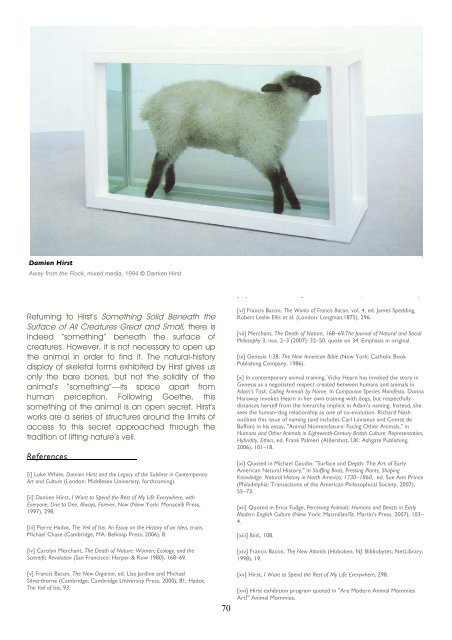Meet Animal Meat - Antennae The Journal of Nature in Visual Culture
Meet Animal Meat - Antennae The Journal of Nature in Visual Culture
Meet Animal Meat - Antennae The Journal of Nature in Visual Culture
You also want an ePaper? Increase the reach of your titles
YUMPU automatically turns print PDFs into web optimized ePapers that Google loves.
Damien Hirst<br />
Away from the Flock, mixed media, 1994 © Damien Hirst<br />
Return<strong>in</strong>g to Hirst’s Someth<strong>in</strong>g Solid Beneath the<br />
Surface <strong>of</strong> All Creatures Great and Small, there is<br />
<strong>in</strong>deed “someth<strong>in</strong>g” beneath the surface <strong>of</strong><br />
creatures. However, it is not necessary to open up<br />
the animal <strong>in</strong> order to f<strong>in</strong>d it. <strong>The</strong> natural-history<br />
display <strong>of</strong> skeletal forms exhibited by Hirst gives us<br />
only the bare bones, but not the solidity <strong>of</strong> the<br />
animal’s “someth<strong>in</strong>g”—its space apart from<br />
human perception. Follow<strong>in</strong>g Goethe, this<br />
someth<strong>in</strong>g <strong>of</strong> the animal is an open secret. Hirst’s<br />
works are a series <strong>of</strong> structures around the limits <strong>of</strong><br />
access to this secret approached through the<br />
tradition <strong>of</strong> lift<strong>in</strong>g nature’s veil.<br />
References<br />
[i] Luke White, Damien Hirst and the Legacy <strong>of</strong> the Sublime <strong>in</strong> Contemporary<br />
Art and <strong>Culture</strong> (London: Middlesex University, forthcom<strong>in</strong>g).<br />
[ii] Damien Hirst, I Want to Spend the Rest <strong>of</strong> My Life Everywhere, with<br />
Everyone, One to One, Always, Forever, Now (New York: Monacelli Press,<br />
1997), 298.<br />
[iii] Pierre Hadot, <strong>The</strong> Veil <strong>of</strong> Isis: An Essay on the History <strong>of</strong> an Idea, trans.<br />
Michael Chase (Cambridge, MA: Belknap Press, 2006), 8.<br />
[iv] Carolyn Merchant, <strong>The</strong> Death <strong>of</strong> <strong>Nature</strong>: Women, Ecology, and the<br />
Scientific Revolution (San Francisco: Harper & Row 1980), 168–69.<br />
[v] Francis Bacon, <strong>The</strong> New Organon, ed. Lisa Jard<strong>in</strong>e and Michael<br />
Silverthorne (Cambridge: Cambridge University Press, 2000), 81; Hadot,<br />
<strong>The</strong> Veil <strong>of</strong> Isis, 93.<br />
70<br />
[viii] Simon Lumsden, "Hegel, Derrida and the Subject," Cosmos and History:<br />
[vi] Francis Bacon, <strong>The</strong> Works <strong>of</strong> Francis Bacon, vol. 4, ed. James Spedd<strong>in</strong>g,<br />
Robert Leslie Ellis et al. (London: Longman,1875), 296.<br />
[vii] Merchant, <strong>The</strong> Death <strong>of</strong> <strong>Nature</strong>, 168–69.<strong>The</strong> <strong>Journal</strong> <strong>of</strong> Natural and Social<br />
Philosophy 3, nos. 2–3 (2007): 32–50, quote on 34. Emphasis <strong>in</strong> orig<strong>in</strong>al.<br />
[ix] Genesis 1:28, <strong>The</strong> New American Bible (New York: Catholic Book<br />
Publish<strong>in</strong>g Company, 1986).<br />
[x] In contemporary animal tra<strong>in</strong><strong>in</strong>g, Vicky Hearn has <strong>in</strong>voked the story <strong>in</strong><br />
Genesis as a negotiated respect created between humans and animals <strong>in</strong><br />
Adam's Task: Call<strong>in</strong>g <strong>Animal</strong>s by Name. In Companion Species Manifesto, Donna<br />
Haraway <strong>in</strong>vokes Hearn <strong>in</strong> her own tra<strong>in</strong><strong>in</strong>g with dogs, but respectfully<br />
distances herself from the hierarchy implicit <strong>in</strong> Adam's nam<strong>in</strong>g. Instead, she<br />
sees the human–dog relationship as one <strong>of</strong> co-evolution. Richard Nash<br />
outl<strong>in</strong>es this issue <strong>of</strong> nam<strong>in</strong>g (and <strong>in</strong>cludes Carl L<strong>in</strong>naeus and Comte de<br />
Buffon) <strong>in</strong> his essay, "<strong>Animal</strong> Nomenclature: Fac<strong>in</strong>g Other <strong>Animal</strong>s," <strong>in</strong><br />
Humans and Other <strong>Animal</strong>s <strong>in</strong> Eighteenth-Century British <strong>Culture</strong>: Representation,<br />
Hybridity, Ethics, ed. Frank Palmeri (Aldershot, UK: Ashgate Publish<strong>in</strong>g,<br />
2006), 101–18.<br />
[xi] Quoted <strong>in</strong> Michael Gaudio, "Surface and Depth: <strong>The</strong> Art <strong>of</strong> Early<br />
American Natural History," <strong>in</strong> Stuff<strong>in</strong>g Birds, Press<strong>in</strong>g Plants, Shap<strong>in</strong>g<br />
Knowledge: Natural History <strong>in</strong> North America, 1730–1860, ed. Sue Ann Pr<strong>in</strong>ce<br />
(Philadelphia: Transactions <strong>of</strong> the American Philosophical Society, 2007),<br />
55–73.<br />
[xii] Quoted <strong>in</strong> Erica Fudge, Perceiv<strong>in</strong>g <strong>Animal</strong>s: Humans and Beasts <strong>in</strong> Early<br />
Modern English <strong>Culture</strong> (New York: Macmillan/St. Mart<strong>in</strong>'s Press, 2007), 103–<br />
4.<br />
[xiii] Ibid., 108.<br />
[xiv] Francis Bacon, <strong>The</strong> New Atlantis (Hoboken, NJ: Bibliobytes; NetLibrary,<br />
1998), 19.<br />
[xv] Hirst, I Want to Spend the Rest <strong>of</strong> My Life Everywhere, 298.<br />
[xvi] Hirst exhibition program quoted <strong>in</strong> "Are Modern <strong>Animal</strong> Mommies<br />
Art?" <strong>Animal</strong> Mommies,












